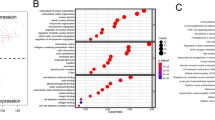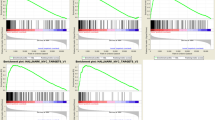Abstract
Aberrant mRNA expression is implicated in uterine corpus endometrial carcinoma (UCEC) oncogenesis and progression. However, effective prognostic biomarkers for UCEC remain limited. We aimed to construct a reliable multi-gene risk model using gene expression profiles. Utilizing TCGA data (543 UCEC samples, 35 controls), we identified 1517 differentially acting genes. Weighted gene co-expression complex analysis (WGCCA), hub gene screening, and risk regression analysis (RRA) were employed to determine prognosis-related genes and construct the risk model. Nomograms visualized risk scores and receiver operator characteristic (ROC) curves assessed model performance. Seven novel prognosis-related hub genes (ANGPT1, ASB2, GAL, GDF7, ONECUT2, SV2B, TRPC6) were identified. The model’s concordance index (C index) by multivariate Cox regression analysis was 0.79. ROC curves yielded AUCs of 0.811 (3-year) and 0.79 (5-year), demonstrating the model’s efficacy in predicting UCEC survival. Our study proposes a promising seven-biomarker risk model for predicting UCEC prognosis, offering potential clinical utility.










Similar content being viewed by others
Data availability
The data used to support this study are available from the corresponding author upon request. The data could be obtained by contacting the corresponding author.
References
Becker J, May A, Gerges C, Anders M, Schmidt C, Veits L et al (2016) The Barrett-associated variants at GDF7 and TBX5 also increase esophageal adenocarcinoma risk. Cancer Med 5(5):888–891
Bray F, Ferlay J, Soerjomataram I, Siegel RL, Torre LA, Jemal A (2018) Global cancer statistics 2018: GLOBOCAN estimates of incidence and mortality worldwide for 36 cancers in 185 countries. CA Cancer J Clin 68(6):394–424
Chaudhry P, Asselin E (2009) Resistance to chemotherapy and hormone therapy in endometrial cancer. Endocr Relat Cancer 16(2):363–380
Che D, Wei H, Yang Z, Zhang Y, Ma S, Zhou X (2019) Application of transvaginal sonographic elastography to distinguish endometrial cancer from benign masses. Am J Transl Res 11(2):1049–1057
Chen W, Zheng R, Baade PD, Zhang S, Zeng H, Bray F et al (2016) Cancer statistics in China, 2015. CA Cancer J Clin 66(2):115–132
De Angelis R, Sant M, Coleman MP, Francisci S, Baili P, Pierannunzio D et al (2014) Cancer survival in Europe 1999–2007 by country and age: results of EUROCARE–5-a population-based study. Lancet Oncol 15(1):23–34
Diez-Bello R, Jardin I, Lopez JJ, El Haouari M, Ortega-Vidal J, Altarejos J et al (2019) (-)Oleocanthal inhibits proliferation and migration by modulating Ca(2+) entry through TRPC6 in breast cancer cells. Biochim Biophys Acta Mol Cell Res 1866(3):474–485
Geng R, Zheng Y, Zhao L, Huang X, Qiang R, Zhang R et al (2020) RNF183 is a prognostic biomarker and correlates with tumor purity, immune infiltrates in uterine corpus endometrial carcinoma. Front Genet 11:595733
Gordon J, Reagan JW, Finkle WD, Ziel HK (1977) Estrogen and endometrial carcinoma. An independent pathology review supporting original risk estimate. N Engl J Med 297(11):570–1
Guibal FC, Moog-Lutz C, Smolewski P, Di Gioia Y, Darzynkiewicz Z, Lutz PG et al (2002) ASB-2 inhibits growth and promotes commitment in myeloid leukemia cells. J Biol Chem 277(1):218–224
Guo H, Ci X, Ahmed M, Hua JT, Soares F, Lin D et al (2019) ONECUT2 is a driver of neuroendocrine prostate cancer. Nat Commun 10(1):278
Guset G, Costi S, Lazar E, Dema A, Cornianu M, Vernic C et al (2010) Expression of vascular endothelial growth factor (VEGF) and assessment of microvascular density with CD34 as prognostic markers for endometrial carcinoma. Rom J Morphol Embryol 51(4):677–682
Hayes AJ, Huang WQ, Yu J, Maisonpierre PC, Liu A, Kern FG et al (2000) Expression and function of angiopoietin-1 in breast cancer. Br J Cancer 83(9):1154–1160
Janz R, Goda Y, Geppert M, Missler M, Sudhof TC (1999) SV2A and SV2B function as redundant Ca2+ regulators in neurotransmitter release. Neuron 24(4):1003–1016
Kanazawa T, Iwashita T, Kommareddi P, Nair T, Misawa K, Misawa Y et al (2007) Galanin and galanin receptor type 1 suppress proliferation in squamous carcinoma cells: activation of the extracellular signal regulated kinase pathway and induction of cyclin-dependent kinase inhibitors. Oncogene 26(39):5762–5771
Kaur S, Lotsari JE, Al-Sohaily S, Warusavitarne J, Kohonen-Corish MR, Peltomaki P (2015) Identification of subgroup-specific miRNA patterns by epigenetic profiling of sporadic and Lynch syndrome-associated colorectal and endometrial carcinoma. Clin Epigenetics 7:20
Kim SI, Lee JW, Lee N, Lee M, Kim HS, Chung HH et al (2018) LYL1 gene amplification predicts poor survival of patients with uterine corpus endometrial carcinoma: analysis of the Cancer genome atlas data. BMC Cancer 18(1):494
Lan T, Mu C, Wang Z, Wang Y, Li Y, Mai Y et al (2020) Diagnostic and prognostic values of serum EpCAM, TGM2, and HE4 levels in endometrial cancer. Front Oncol 10:1697
Langfelder P, Horvath S (2008) WGCNA: an R package for weighted correlation network analysis. BMC Bioinformatics 9:559
Lu T, Wu B, Yu Y, Zhu W, Zhang S, Zhang Y et al (2018) Blockade of ONECUT2 expression in ovarian cancer inhibited tumor cell proliferation, migration, invasion and angiogenesis. Cancer Sci 109(7):2221–2234
Lu H, Ju DD, Yang GD, Zhu LY, Yang XM, Li J et al (2019) Targeting cancer stem cell signature gene SMOC-2 Overcomes chemoresistance and inhibits cell proliferation of endometrial carcinoma. EBioMedicine 40:276–289
Morrison C, Zanagnolo V, Ramirez N, Cohn DE, Kelbick N, Copeland L et al (2006) HER-2 is an independent prognostic factor in endometrial cancer: association with outcome in a large cohort of surgically staged patients. J Clin Oncol 24(15):2376–2385
Nagata J, Kijima H, Hatanaka H, Tokunaga T, Kamochi J, Abe Y et al (2002) Angiopoietin-1 and vascular endothelial growth factor expression in human esophageal cancer. Int J Mol Med 10(4):423–426
Nie L, Zhao Y, Wu W, Yang YZ, Wang HC, Sun XH (2011) Notch-induced Asb2 expression promotes protein ubiquitination by forming non-canonical E3 ligase complexes. Cell Res 21(5):754–769
Palles C, Chegwidden L, Li X, Findlay JM, Farnham G, Castro Giner F et al (2015) Polymorphisms near TBX5 and GDF7 are associated with increased risk for Barrett’s esophagus. Gastroenterology 148(2):367–78
Quinn MJ (2014) Secondary analyses from a randomized clinical trial: age as the key prognostic factor in endometrial carcinoma. Am J Obstet Gynecol 210(6):588
Raffone A, Travaglino A, Mascolo M, Carbone L, Guida M, Insabato L et al (2019) TCGA molecular groups of endometrial cancer: pooled data about prognosis. Gynecol Oncol 155(2):374–383
Riben MW, Malfetano JH, Nazeer T, Muraca PJ, Ambros RA, Ross JS (1997) Identification of HER-2/neu oncogene amplification by fluorescence in situ hybridization in stage I endometrial carcinoma. Mod Pathol 10(8):823–831
Ritchie ME, Phipson B, Wu D, Hu Y, Law CW, Shi W et al (2015) limma powers differential expression analyses for RNA-sequencing and microarray studies. Nucleic Acids Res 43(7):e47
Robinson MD, McCarthy DJ, Smyth GK (2010) edgeR: a Bioconductor package for differential expression analysis of digital gene expression data. Bioinformatics 26(1):139–140
Saijo M, Nakamura K, Ida N, Nasu A, Yoshino T, Masuyama H et al (2019) Histologic appearance and immunohistochemistry of DNA mismatch repair protein and p53 in endometrial carcinosarcoma: impact on prognosis and insights into tumorigenesis. Am J Surg Pathol 43(11):1493–1500
Scanlon CS, Banerjee R, Inglehart RC, Liu M, Russo N, Hariharan A et al (2015) Galanin modulates the neural niche to favour perineural invasion in head and neck cancer. Nat Commun 6:6885
Sheng Y, Wang H, Liu D, Zhang C, Deng Y, Yang F et al (2016) Methylation of tumor suppressor gene CDH13 and SHP1 promoters and their epigenetic regulation by the UHRF1/PRMT5 complex in endometrial carcinoma. Gynecol Oncol 140(1):145–151
Siegel RL, Miller KD, Jemal A (2019) Cancer statistics, 2019. CA Cancer J Clin 69(1):7–34
Song Y, Liu G, Liu S, Chen R, Wang N, Liu Z et al (2019) Helicobacter pylori upregulates TRPC6 via Wnt/beta-catenin signaling to promote gastric cancer migration and invasion. Onco Targets Ther 12:5269–5279
Spinner CA, Lamsoul I, Metais A, Febrissy C, Moog-Lutz C, Lutz PG (2019) The E3 ubiquitin ligase Asb2alpha in T helper 2 cells negatively regulates antitumor immunity in colorectal cancer. Cancer Immunol Res 7(8):1332–1344
Stewart CJ, Doherty DA, Havlat M, Koay MH, Leung YC, Naran A et al (2013) Transtubal spread of endometrial carcinoma: correlation of intra-luminal tumour cells with tumour grade, peritoneal fluid cytology, and extra-uterine metastasis. Pathology 45(4):382–387
Sun Y, Shen S, Liu X, Tang H, Wang Z, Yu Z et al (2014) MiR-429 inhibits cells growth and invasion and regulates EMT-related marker genes by targeting Onecut2 in colorectal carcinoma. Mol Cell Biochem 390(1–2):19–30
Tian Y, Zhu MX (2018) A novel TRPC6-dependent mechanism of TGF-beta-induced migration and invasion of human hepatocellular carcinoma cells. Sci China Life Sci 61(9):1120–1122
Turbiner J, Moreno-Bueno G, Dahiya S, Sanchez-Estevez C, Hardisson D, Prat J et al (2008) Clinicopathological and molecular analysis of endometrial carcinoma associated with tamoxifen. Mod Pathol 21(8):925–936
Xu W, Zhu S, Zhou Y, Jin Y, Dai H, Wang X (2015) Upregulation of mitogen-inducible gene 6 triggers antitumor effect and attenuates progesterone resistance in endometrial carcinoma cells. Cancer Gene Ther 22(11):536–541
Yu G, Wang LG, Han Y, He QY (2012) clusterProfiler: an R package for comparing biological themes among gene clusters. OMICS 16(5):284–287
Funding
This work was supported by grants from Beijing Natural Science Foundation (grant number 7234411), the Non-profit Central Research Institute Fund of Chinese Academy of Medical Sciences (NO. 3332023008), China Postdoctoral Science Foundation (2023M740320) and Beijing Hospital Fundation (BJ-2020-138).
Author information
Authors and Affiliations
Contributions
Falin He and Feng Deng designed the study. Xin Sui, Penghui Feng, and Jie Guo wrote the original draft. Xingtong Chen collected the raw data. Yanmin Zhang performed statistical and bioinformatics analyses. Falin He and Feng Deng supervised the study. All authors read and approved the final version of the manuscript.
Corresponding authors
Ethics declarations
Conflict of interest
The authors declare no competing interests.
Additional information
Communicated by: Ewa Ziętkiewicz
Publisher's Note
Springer Nature remains neutral with regard to jurisdictional claims in published maps and institutional affiliations.
Rights and permissions
Springer Nature or its licensor (e.g. a society or other partner) holds exclusive rights to this article under a publishing agreement with the author(s) or other rightsholder(s); author self-archiving of the accepted manuscript version of this article is solely governed by the terms of such publishing agreement and applicable law.
About this article
Cite this article
Sui, X., Feng, P., Guo, J. et al. Novel targets and their functions in the prognosis of uterine corpus endometrial cancer patients. J Appl Genetics (2024). https://doi.org/10.1007/s13353-024-00856-1
Received:
Revised:
Accepted:
Published:
DOI: https://doi.org/10.1007/s13353-024-00856-1




